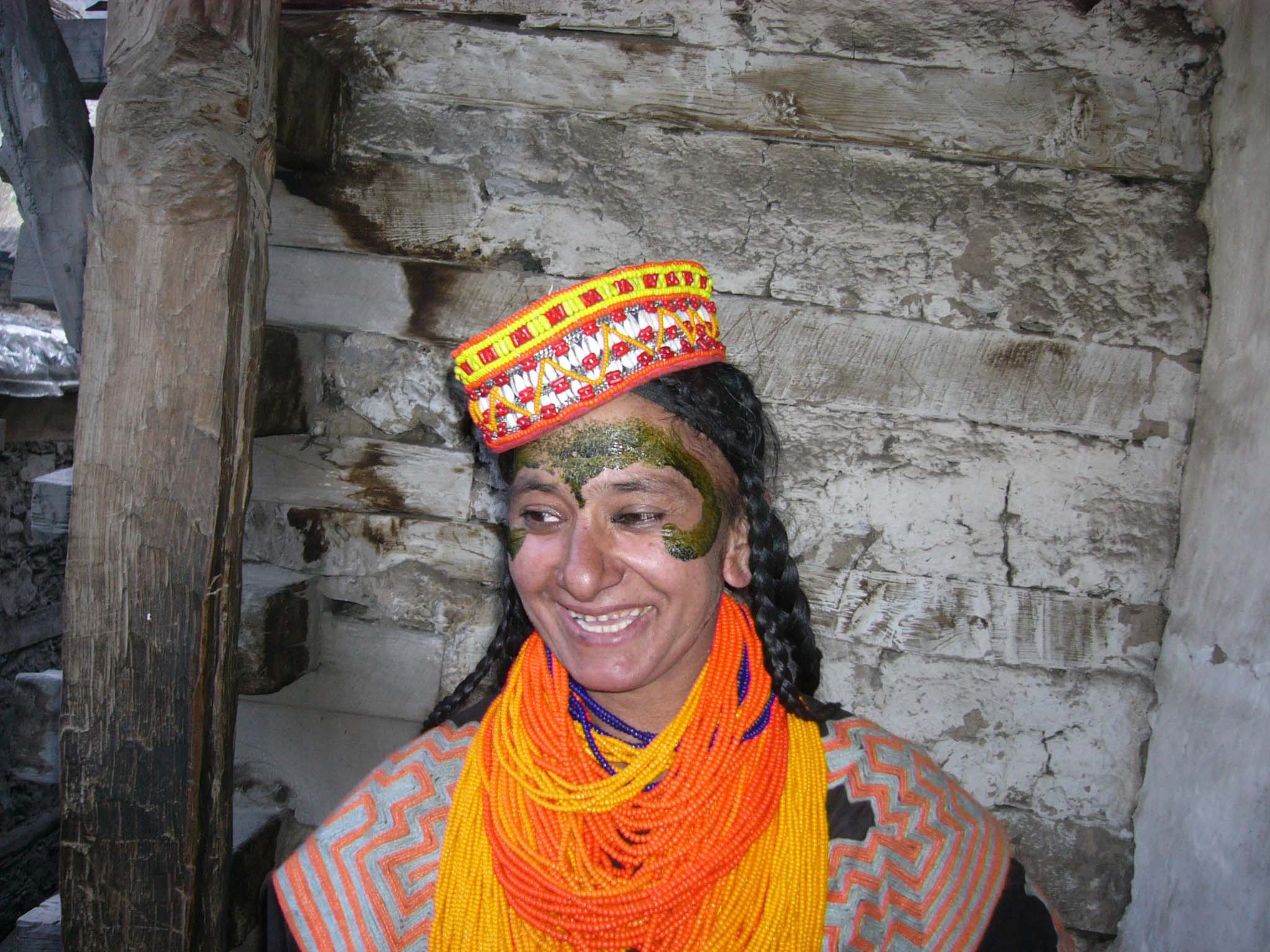On The Verge Of Extinction
The relatively mysterious Kalash people are an ancient isolated tribe living a primitive lifestyle high up in the remote valleys of the Hindu Kush mountain range.
They’re Pakistan’s smallest ethnic group, with an intriguing belief system that is not widely accepted in the primarily-Muslim nation. As a result, they've been under threat for centuries—fighting for the survival of their culture and religious identity—and are now on the verge of extinction.
This is their story.
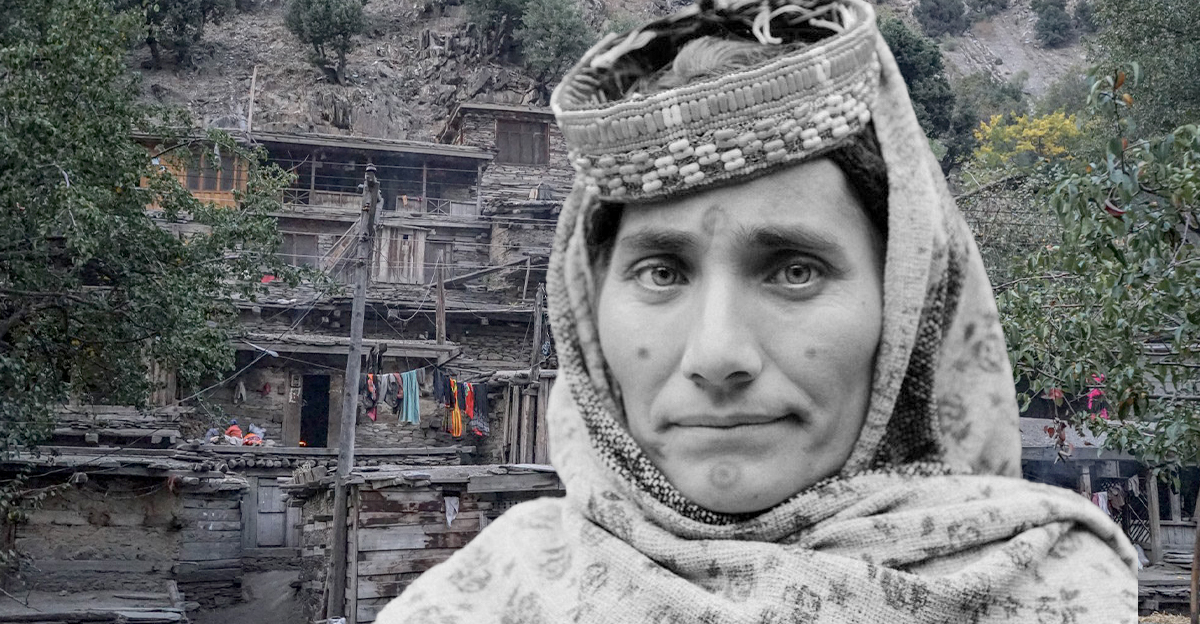
Who Are They?
The Kalash are a group of indigenous people in Pakistan who are often described as extremely hospitable and humble people with elaborate, unique lifestyles and traditions.
Their settlements have been well preserved in terms of architecture and customs, and their traditions have been carried strong throughout the generations—even though many are in contrast to the surrounding Pakistani culture.
 AbdulBari, CC BY-SA 4.0, Wikimedia Commons
AbdulBari, CC BY-SA 4.0, Wikimedia Commons
What Is Their Population?
It is believed that there are less than 4,000 Kalash people remaining. At one point, their population was at least double this, but constant threats to their lives have continuously—and significantly—decreased their population.
At this point, it is believed that the Kalash people may be on the verge of extinction.
 Martin Jung, CC BY-SA 3.0, Wikimedia Commons
Martin Jung, CC BY-SA 3.0, Wikimedia Commons
What Is Their History?
The Kalash claim to descend from the armies of Alexander the Great, who were left behind after his armed campaign. Some also consider them to be descendants of the Gandhari people—an ancient culture from the Iron Age.
However, their origin remains a mystery, as there are many traditions regarding their early history.
 Ziegler175, CC BY-SA 3.0, Wikimedia Commons
Ziegler175, CC BY-SA 3.0, Wikimedia Commons
What Do They Look Like?
The Kalash have Caucasian features—fair complexions and light-colored eyes. Their hair ranges from dark to light brown and they are of average height.
Their physical appearance contrasts sharply with that of their Pashtun and Kho neighbors, making them easily recognizable.
 Azmat akbar, CC BY-SA 4.0, Wikimedia Commons
Azmat akbar, CC BY-SA 4.0, Wikimedia Commons
What Is Their Demeanor?
The Kalash people are said to be extremely harmonious—both with nature and with people. They avoid hurting people and are accepting of all others.
The vast majority of them claim to be very happy with their primitive lifestyle and do not wish to join modern societies.
The Kalash are very welcoming of visitors, with many tourists reporting only good experiences. However, the Kalash themselves have said they prefer the visitors who stay and interact with them, rather than those who come to take photos and leave.
 Kashifkayani123, CC BY-SA 3.0, Wikimedia Commons
Kashifkayani123, CC BY-SA 3.0, Wikimedia Commons
Where Do They Live?
In the Khyber-Pakhtunkhwa province of Pakistan, the Kalash people live in three isolated mountain valleys: Bumburet, Rumbur, and Birir. These valleys are considered “The Kalasha Valleys".
These beautiful valleys, surrounded by the Hindu Kush mountain range, are covered in rich oak forests and open toward the Kunar River, about 20 kilometers downstream of the city of Chitral.
 Addden321, CC BY-SA 4.0, Wikimedia Commons
Addden321, CC BY-SA 4.0, Wikimedia Commons
What Is The Climate Like?
The summers are mild, with average maximum temperatures between 23 and 27 °C (73 and 81 °F)—which is typical of high elevation regions without large bodies of water to regulate the temperature.
Winters, however, can be very cold.
 Waleed0343, CC BY-SA 4.0, Wikimedia Commons
Waleed0343, CC BY-SA 4.0, Wikimedia Commons
What Is The Land Like?
The region is extremely fertile, allowing for an abundance of agricultural opportunities. The powerful (and dangerous) rivers that flow through the valleys are used to power grinding mills and ingenious irrigation systems to water farm fields.
The stunning surroundings of untouched forest and snow-capped mountains provide a serene and natural environment, unlike anywhere else in the world.
 Yasirzaman11, CC BY-SA 3.0, Wikimedia Commons
Yasirzaman11, CC BY-SA 3.0, Wikimedia Commons
How High Up In The Mountains Do They Live?
The Kalash villages in all three valleys are located at an incredible height of approximately 6,200 feet to 7,300 feet. These villages are accessible by car, but the journey is challenging and should be reserved for experienced drivers.
What Are Their Villages Like?
The Birir village is the most remote village. It has houses, streets, and roadways built from stones and wood, but has the least facilities.
Bumburet is the most developed and accessible village of the three, but has a more mixed population that includes some non-Kalash residents.
Rumbur is less developed than Bumburet, and the people are predominantly Kalash.
 Nastya Smirnova RF, Shutterstock
Nastya Smirnova RF, Shutterstock
What Are Their Houses Like?
The houses are built on top of hills surrounding the valley. Many of the traditional wooden homes are built on top of one another, with staircases that connect the dwellings.
The floors of a Kalash home are nothing but ground cover, which can become very cold in winter months. Windows are open holes that are sometimes covered with plastic or wooden planks during the winter months.
 Azmat akbar, CC BY-SA 4.0, Wikimedia Commons
Azmat akbar, CC BY-SA 4.0, Wikimedia Commons
What Is Their Infrastructure Like?
The Kalash villages may be small and severely remote, but they do have quite a bit of infrastructure that has been carefully and strategically built over many generations. Most of these buildings are very old, very basic, and not at all what you would find in a modern city. However, new builds have taken place in recent years in the more developed valleys.
From small hotels, temples, and museums to shops, schools, and cemeteries, the Kalash people satisfy their basic needs—but only their basic needs.
 Numan Ali, CC BY-SA 4.0, Wikimedia Commons
Numan Ali, CC BY-SA 4.0, Wikimedia Commons
What Do The Kalash Villages Lack?
While there may be some amenities similar to that of a modern city, the Kalash villages remain very basic and traditional.
In the most traditional parts of the community, there are no official doctors or medical facilities, no mobile phones or internet, no newspapers, and no tarmac roads. Most areas do not have electricity or running water, either.
And access to some very-much needed amenities is surprisingly scarce.
 Shirjeel Imran Malik, CC BY-SA 4.0, Wikimedia Commons
Shirjeel Imran Malik, CC BY-SA 4.0, Wikimedia Commons
Do They Have Access To Clean Drinking Water?
While it may be assumed that they do, considering the abundance of water from rushing lakes and rivers around them, the majority of Kalash actually don’t have access to clean drinking water.
Running water is especially scarce. Water must be collected and boiled as the rivers are often full of dirty runoff from the mountains.
 Talha Khan, CC BY-SA 3.0, Wikimedia Commons
Talha Khan, CC BY-SA 3.0, Wikimedia Commons
What Is Their Hygiene Like?
The Kalash people do their absolute best to keep up with good hygiene, even though their circumstances can make it challenging.
Without access to modern cleaning supplies and basic running water, the remote Kalash communities are hard to keep clean.
Clothing is not washed regularly, and their wooden shacks are built directly on dirt covered ground, and get nothing more than an occasional sweep. The homes are said to be blackened inside from constantly having a fire lit for both warmth and cooking.
 Cyber.Eyes.2005, CC BY-SA 4.0, Wikimedia Commons
Cyber.Eyes.2005, CC BY-SA 4.0, Wikimedia Commons
Do The Kids Go To School?
Yes, the Kalash children attend basic schooling. Among the three valleys, there are a handful of primary schools, two middle schools, and one high school.
Among the population, about 18 percent of women and 15 percent of men are considered “educated". The overall literacy rate is 25 percent.
Compared to boys, there are more Kalash girls in schools.
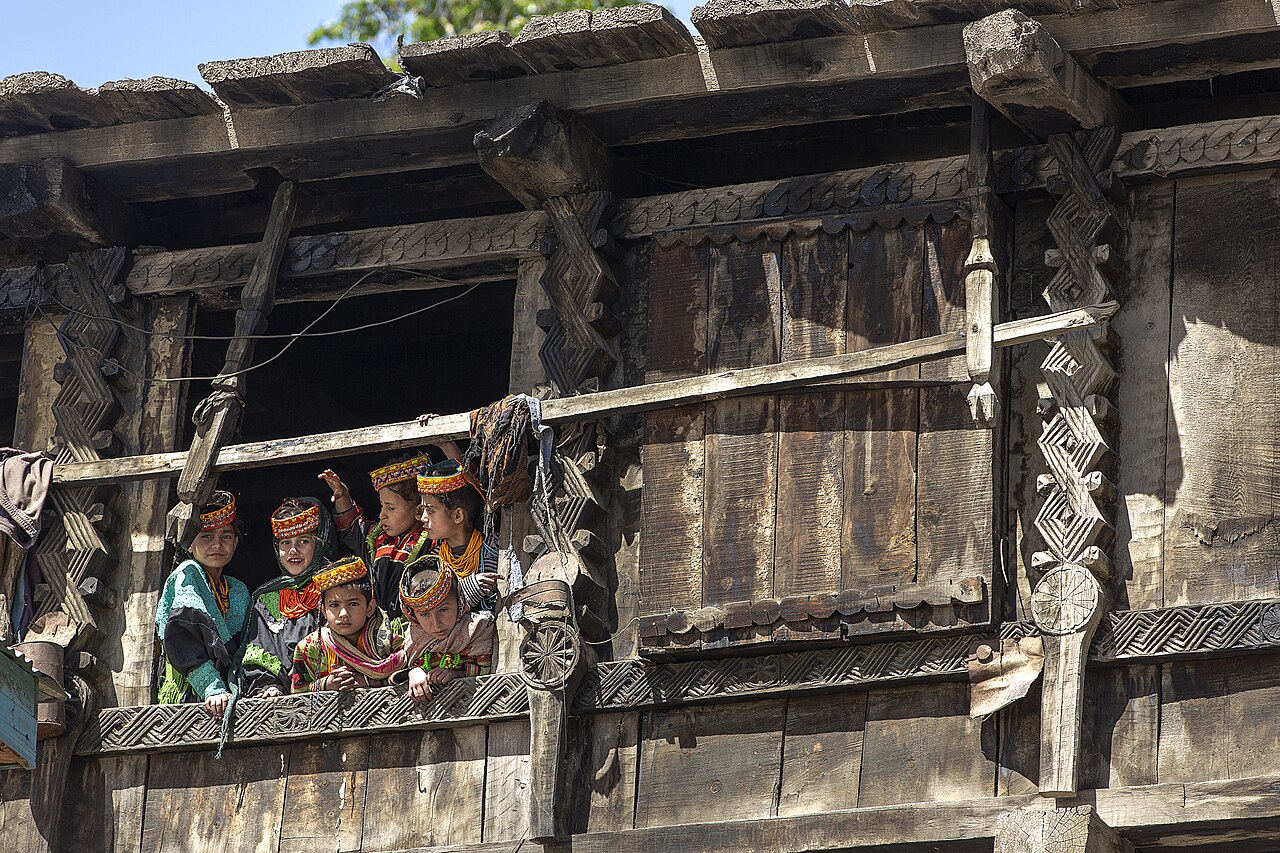 Tahsin Shah, CC BY-SA 4.0, Wikimedia Commons
Tahsin Shah, CC BY-SA 4.0, Wikimedia Commons
What Do They Wear?
The Kalash people’s traditional clothing is one of the most significant elements of their culture. They wear elaborate, colorful clothing that is strictly handmade.
Most Kalash women make about five dresses per year, and wear them interchangeably. The material used is locally called 'Shu'—a woolen fabric material sourced from Chitral.
However, modern clothing—such as winter jackets—are somewhat accessible, though it is not easy and not in abundance.
 Tahsin A Shah, CC BY-SA 4.0, Wikimedia Commons
Tahsin A Shah, CC BY-SA 4.0, Wikimedia Commons
How Do They Accessorize?
Aside from the wool material, clothing and headgear are also made using silk with beads embroidered in intricate designs.
'Kalashi topi' or 'Khalpol' is a beaded accessory that is uniquely designed by each individual, and is an everyday clothing staple for the villagers. It is typically designed differently for males and females.
 Tahsin A Shah, CC BY-SA 4.0, Wikimedia Commons
Tahsin A Shah, CC BY-SA 4.0, Wikimedia Commons
What Are Their Shoes Made From?
The Kalash people make their shoes a little differently than others in surrounding regions. 'Khon' or 'Chitrali shoes' are said to be long, high, and more suitable for rough terrain and colder climates.
 manalahmadkhan, CC BY 2.0, Wikimedia Commons
manalahmadkhan, CC BY 2.0, Wikimedia Commons
What Do They Eat?
The Kalash people eat a variety of delicious, well-prepared food. Their main source of sustenance is agriculture, but they also keep some livestock. And while they do eat meat—unlike their Muslim neighbors—they do somewhat keep it to a minimum, with vegetation being their primary food source.
They grow maize, wheat, and lentils and have many fruit orchards which provide them with walnuts, grapes, apples, mulberries, and pears. The only food they import is rice.
Many of their signature dishes are infused with walnuts—including walnut breads and walnut tea.
How Do They Cook?
All of their food is cooked over open fires and wood stoves, as most households do not have electricity. Many of their fruits and vegetables are enjoyed both raw and cooked.
What Is Their Economy Like?
Historically, the Kalash were a goat herding and subsistence farming community that measured wealth in livestock and crops.
However, they are now moving toward a cash-based society, with tourism making up a large portion of their economic activities.
In fact, in recent years, many changes have been made to cater to tourism.
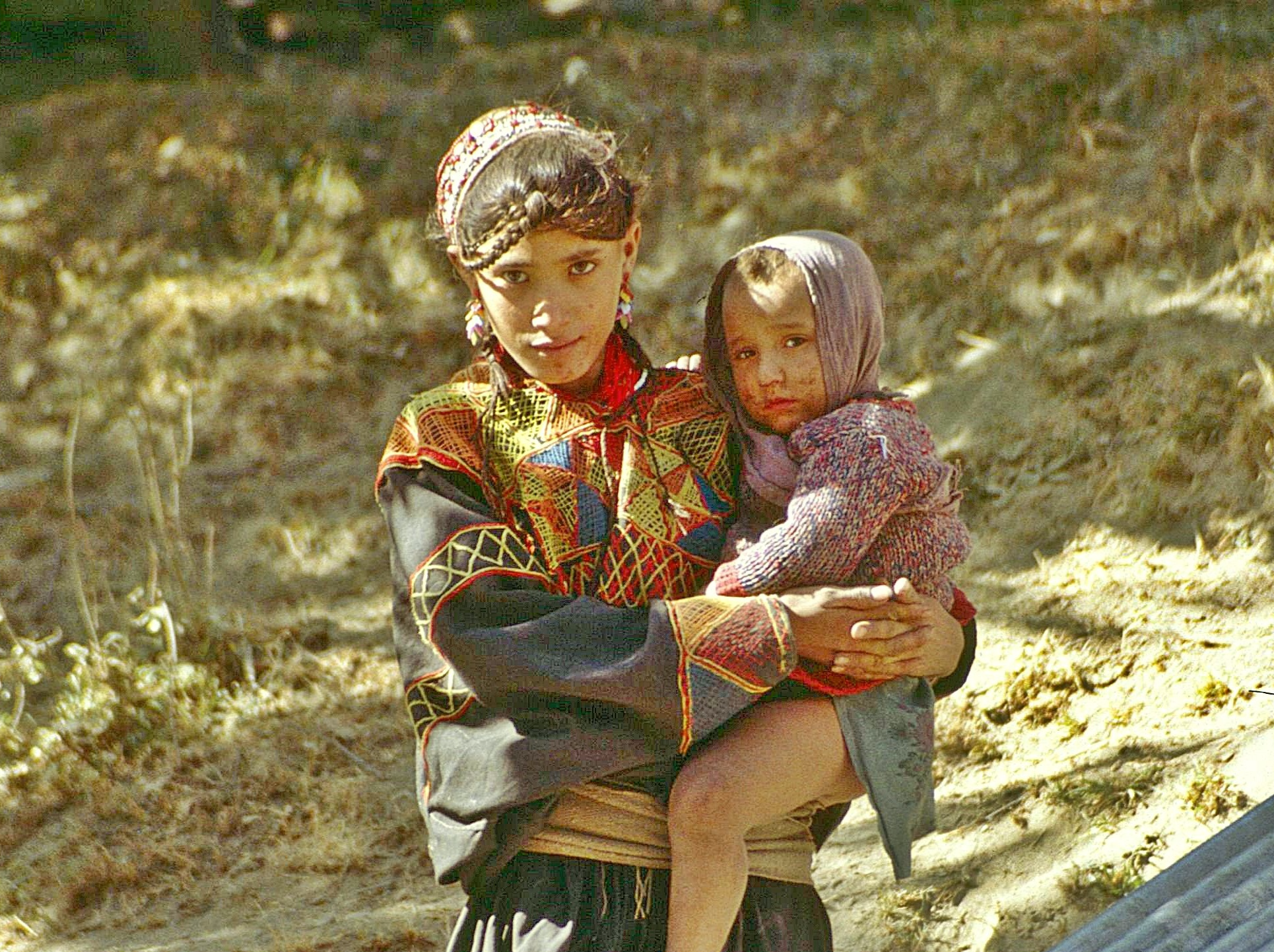 Ziegler175, CC BY-SA 3.0, Wikimedia Commons
Ziegler175, CC BY-SA 3.0, Wikimedia Commons
Tourism In Kalash Villages
To cater to new visitors, the Kalash villages have built small shops, food establishments, and guest houses.
While they are very basic and fit the traditional standards of the community, they are popular among tourists looking for an immersive experience.
Anyone who attempts to enter the valleys must pay a toll to the Pakistani government, which is then used to preserve and care for the Kalash people.
 manalahmadkhan, CC BY 2.0, Wikimedia Commons
manalahmadkhan, CC BY 2.0, Wikimedia Commons
What Jobs Do Kalash People Have?
After the first road was built in the 1970s—which can only be driven on by 4x4 vehicles—jobs opened up to residents, including positions in road maintenance and construction, as well as military, police, and border control.
There are also minor opportunities for employment in hospitality and schools.
 Ishpatanews, CC BY-SA 4.0, Wikimedia Commons
Ishpatanews, CC BY-SA 4.0, Wikimedia Commons
What Are Their Gender Roles Like?
Farming and food preparation is typically done by women, but men also participate. Men have other jobs, such as construction and hospitality. Both genders care for the children, and parenting is a group effort involving all members of the village.
While their employment roles may differ slightly, equality in the Kalash community is rather inspiring.
Kalash Women
While the Kalash community resides in Pakistan, their religious beliefs greatly differ from the conservative Islamic beliefs of their neighbors.
Their non-Muslim religion does not dictate how women behave, or the rights they have. In fact, Kalash women have a great deal of freedom, and are seen as equals to their partners.
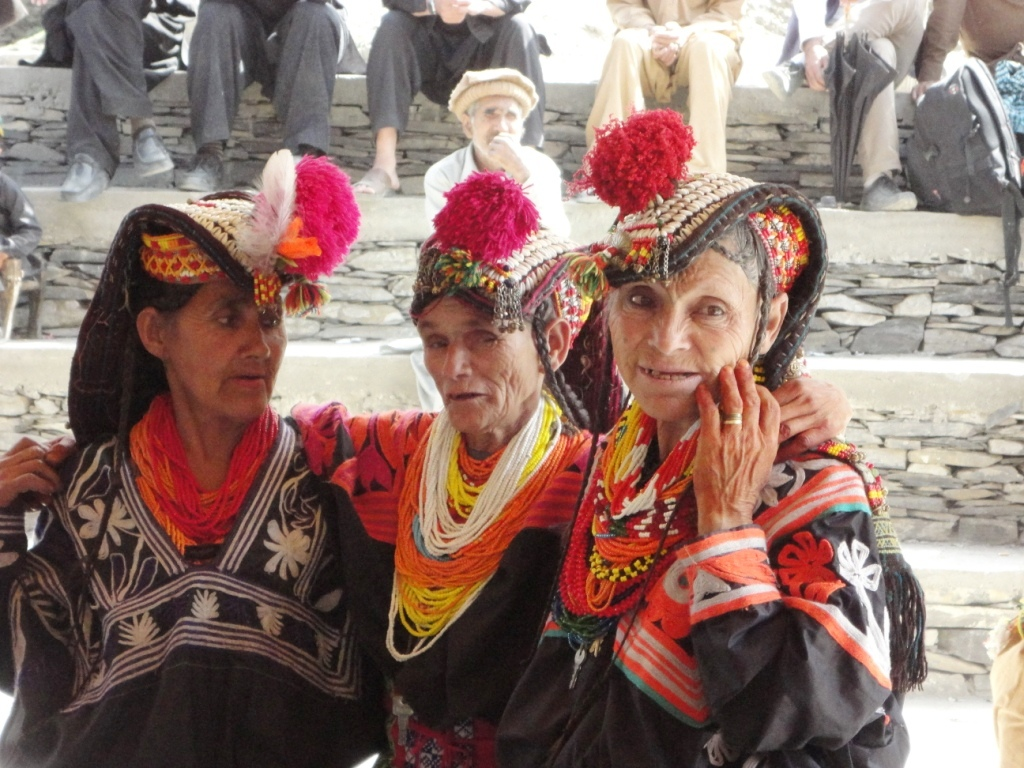 Imnadim, CC BY-SA 4.0, Wikimedia Commons
Imnadim, CC BY-SA 4.0, Wikimedia Commons
What Is Their Religion?
The Kalash people primarily practice the traditional Kalash religion—which is a form of animism and ancestor worship mixed with elements from ancient Indo-Iranian religion and mythology.
This belief system is considered an indigenous religion of Pakistan.
How Does The Kalash Religion Differ From Neighboring Religions?
Unlike the Islamic religion, the Kalash people eat meat, drink booze, and have shamans.
They also have a strong concept for “Pure” and “Impure” in their life—resulting in many different rituals to purify things.
They believe in many gods and goddesses (and even fairies), along with one supreme creator called Dezau.
Historians often compare Kalash mythology to that of ancient Greece—especially because of the sacrificial rituals they practice.
What Did They Sacrifice To The Gods?
The Kalash people believe in many deities and have numerous shrines and alters throughout the valleys where they used to frequently offer goat sacrifices.
In fact, at one time, horses, goats and sheep were all scarified to the gods. However, this practice has phased out over the last few generations.
Even still, numerous other traditional rituals continue to take place regularly.
 Anil Öztas, CC BY-SA 4.0, Wikimedia Commons
Anil Öztas, CC BY-SA 4.0, Wikimedia Commons
How Important Are Rituals?
Kalash rituals are of the potlatch type—meaning they typically consist of a gift-giving feast. By organizing rituals and festivals, a Kalash person gains fame and status within the community.
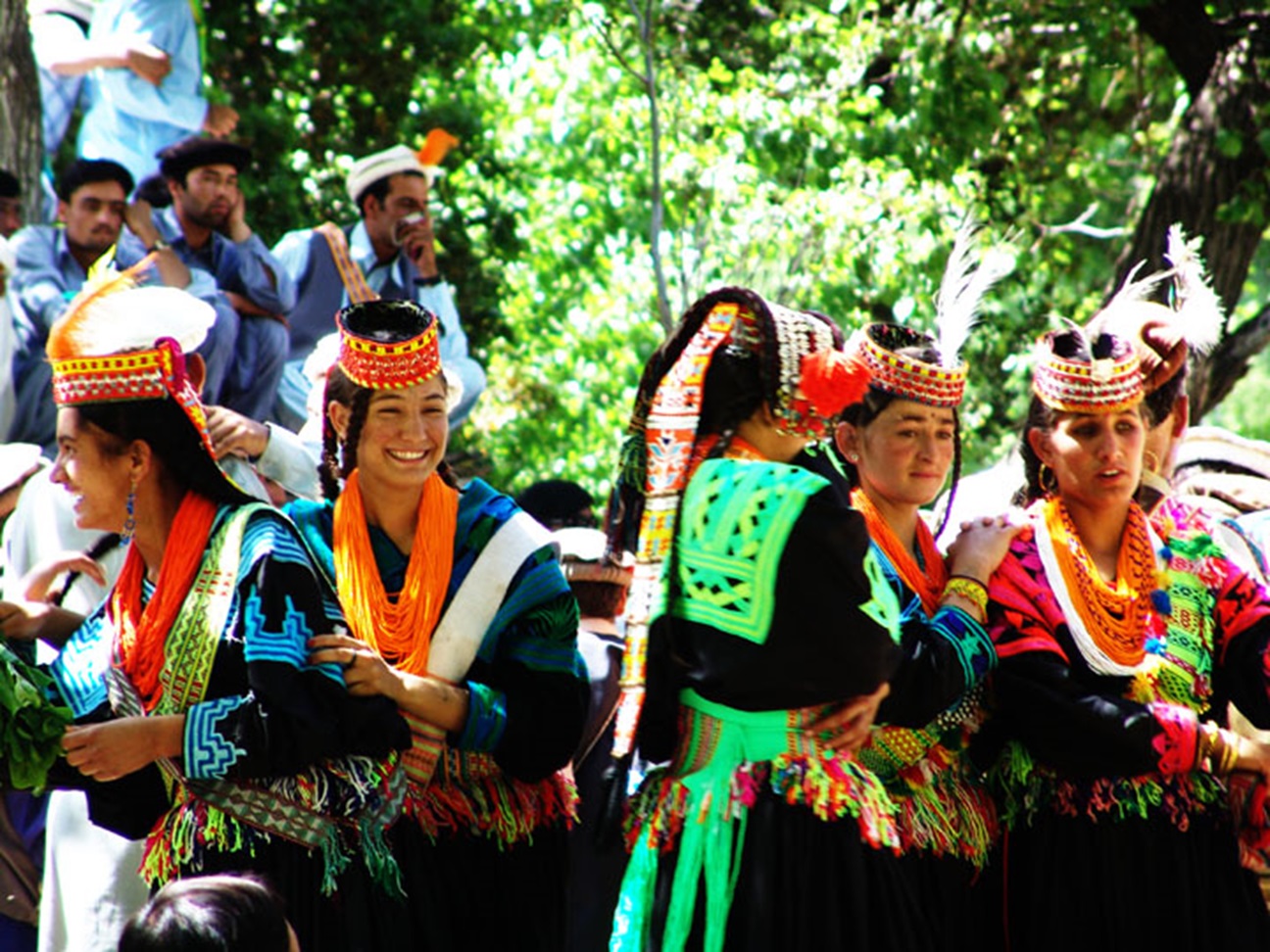 Abrar Alam Khan, CC BY-SA 3.0, Wikimedia Commons
Abrar Alam Khan, CC BY-SA 3.0, Wikimedia Commons
How Important Is Purity?
Rituals have a unique role for prepubescent boys, who are treated as “special” due to their purity. The boys tend goats for the summer months, high up in the mountains where purity is most powerful.
The higher up in the valley, the purer the location.
Purity is extremely important to the Kalash people and is centered around altars, goat stables, the space between the hearth and the back wall of houses, and during festival periods.
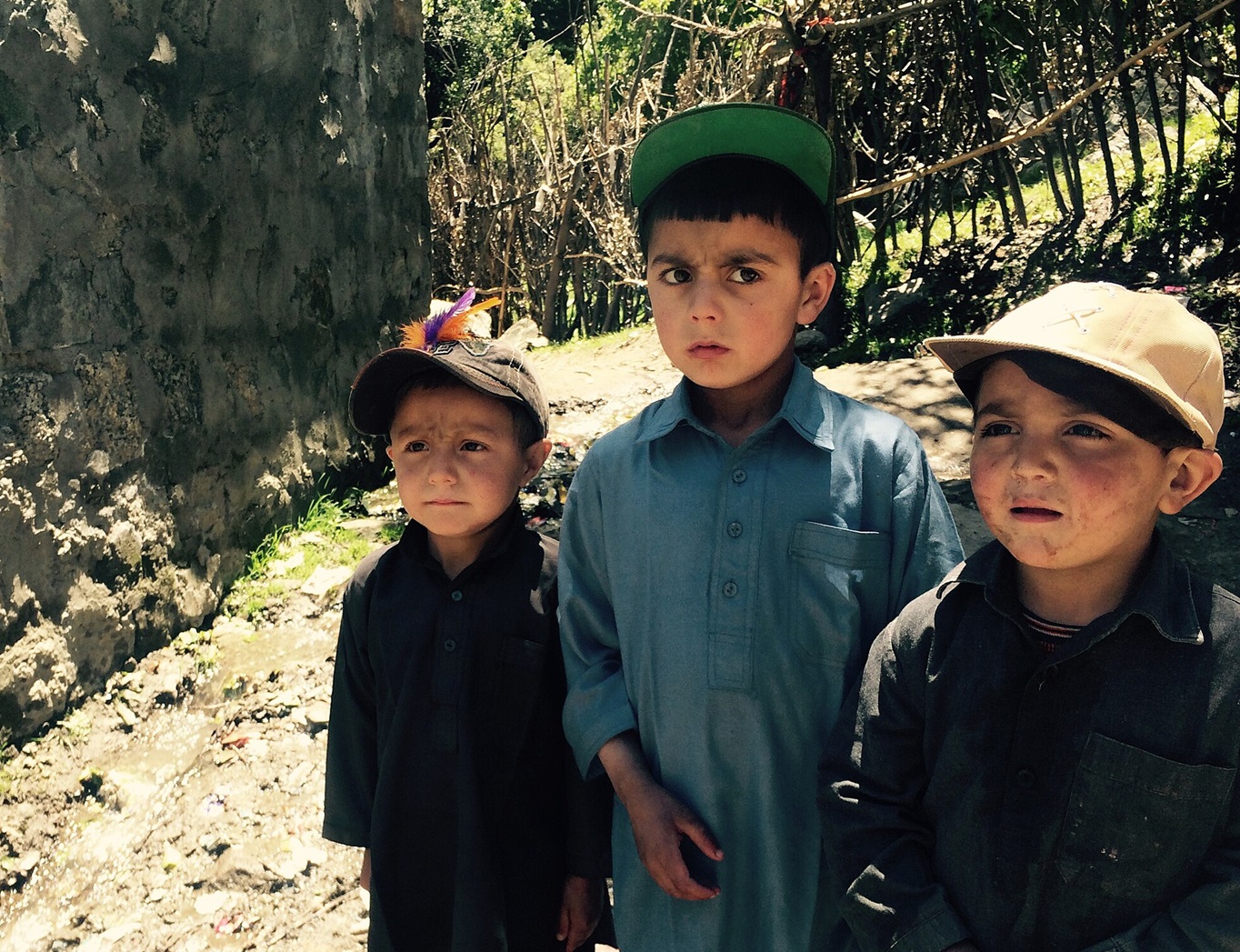 Kashifkayani123, CC BY-SA 3.0, Wikimedia Commons
Kashifkayani123, CC BY-SA 3.0, Wikimedia Commons
What Is Considered Impure?
The Kalash people believe death, decomposition, and the outside Muslim world are impure, as well as women’s menstrual cycles and giving birth.
Because of this, cleansing rituals are required whenever these events occur.
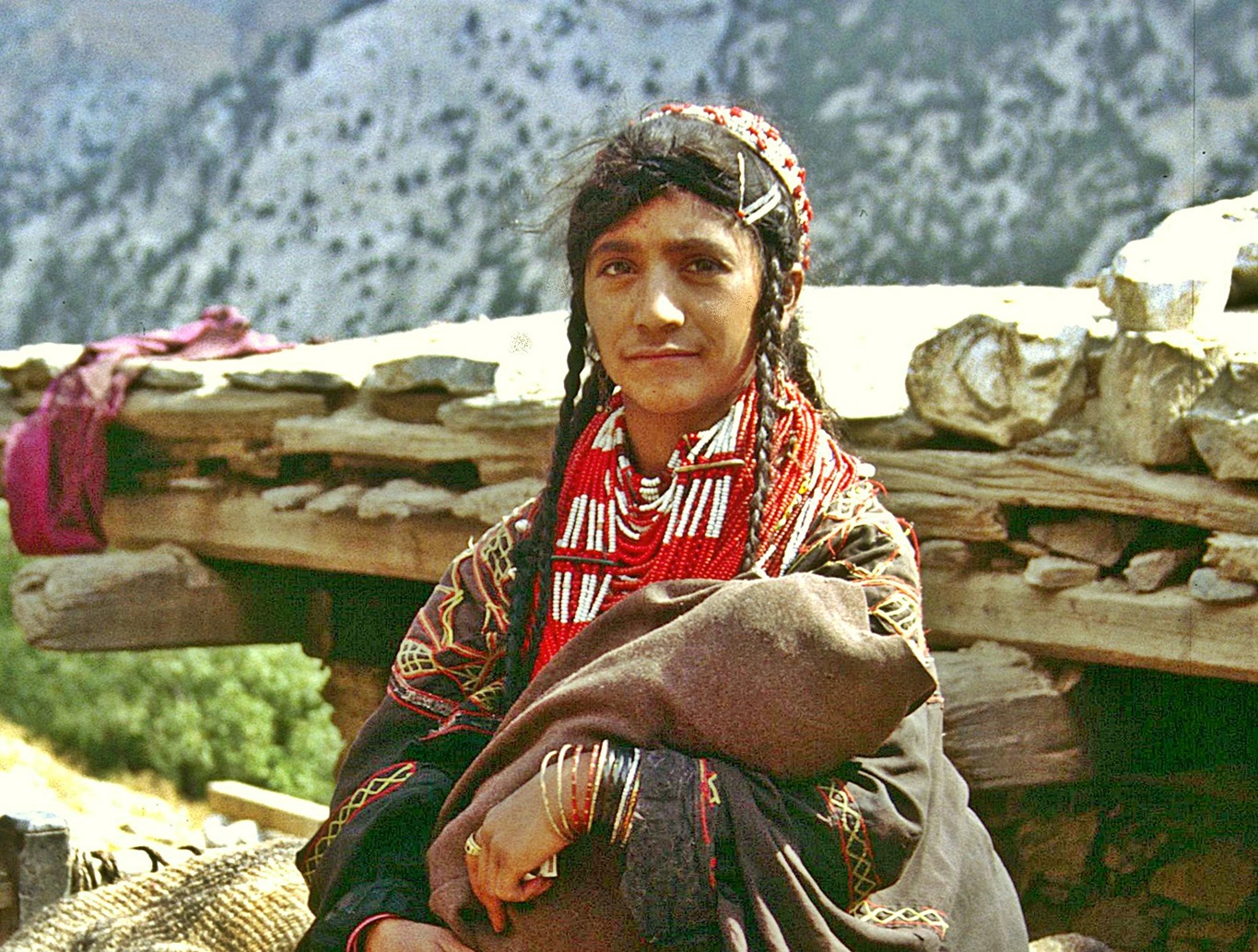 Ziegler175, CC BY-SA 3.0, Wikimedia Commons
Ziegler175, CC BY-SA 3.0, Wikimedia Commons
Funerary Rituals
Kalash people who have passed on are initially laid to rest above ground in ornamented wooden coffins. Wooden effigies are built at the graves of wealthy or honored people. After the lengthy rituals are concluded, the bodies are then buried underground alongside items reflecting their daily life.
Crows represent the late ancestors, and are frequently fed with the left hand at the tombs of the deceased.
But the Kalash's initial funerary ritual is something that has actually attracted global attention due to its unique nature.
 Cyber.Eyes.2005, CC BY-SA 4.0, Wikimedia Commons
Cyber.Eyes.2005, CC BY-SA 4.0, Wikimedia Commons
What Is Their Death Ritual?
Funeral rites are deeply rooted in Kalash traditions, and involve a blend of mourning and celebration.
Women sing religious songs and perform solemn dances around the departed's pillow. Men and young boys partake in drumming and dancing.
They then will sacrifice numerous animals like goats, cows, and bulls—especially for prominent Kalash community members. This symbolizes respect and honor.
Families are required to provide a feast for guests.
 manalahmadkhan, CC BY 2.0, Wikimedia Commons
manalahmadkhan, CC BY 2.0, Wikimedia Commons
What Is Their Menstruation Ritual?
Menstruating girls and women are sent to the 'bashaleni'—the village menstrual building. They are required to stay there until they regain their “purity".
Women also have to give birth in the bashaleni. After the baby is born, a cleansing ritual is performed before the woman can return to her husband.
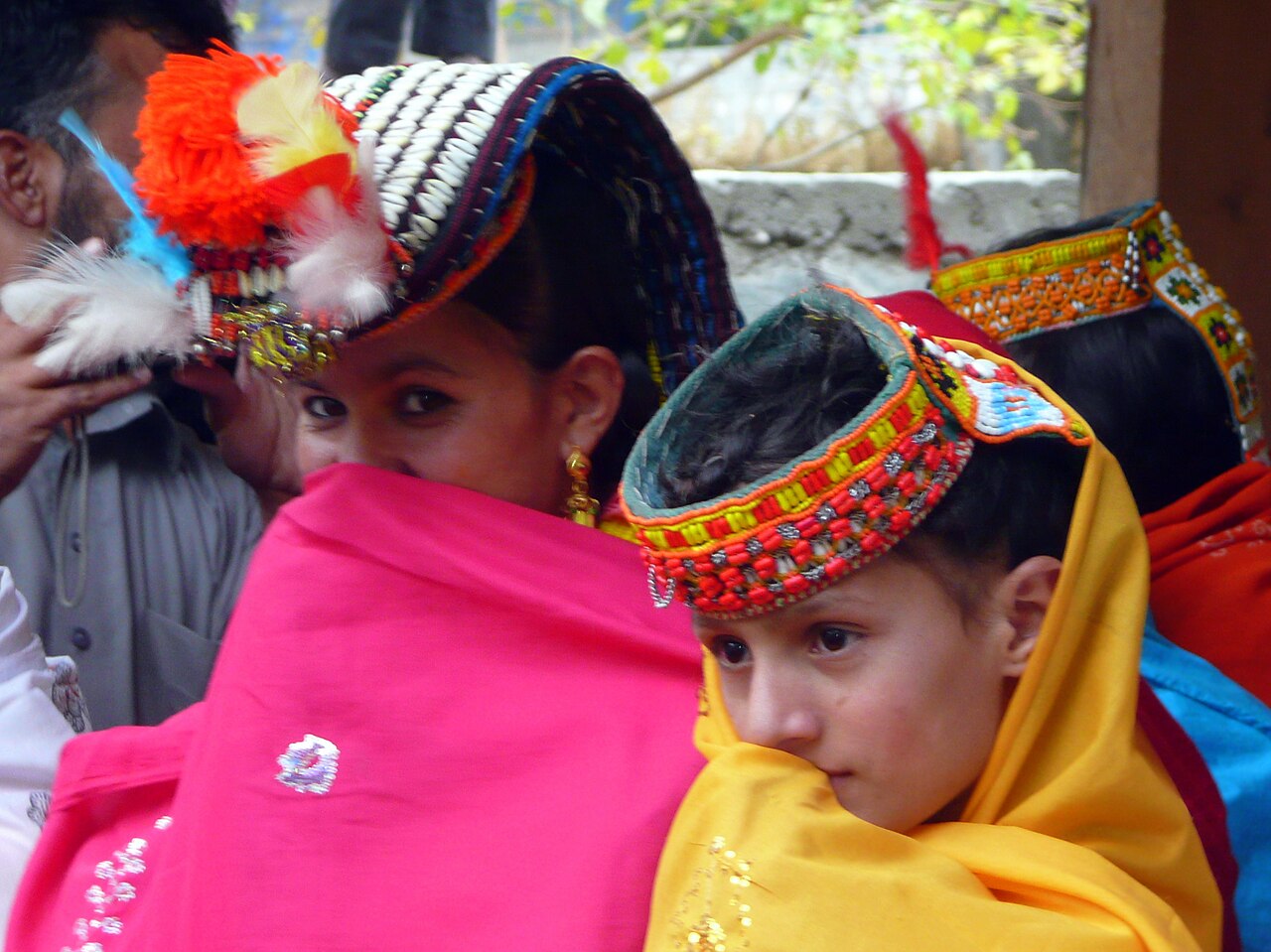 Martin Jung, CC BY-SA 3.0, Wikimedia Commons
Martin Jung, CC BY-SA 3.0, Wikimedia Commons
What Are The Restrictions In The Bashaleni?
This building is located far from other houses in the village and men are not allowed to enter, or even touch the walls of the building in fear of becoming impure if they do.
Food is brought to those who are menstruating by other village women, but they are not allowed to touch them. Many women are usually there at the same time, and spend their time supporting each other, gossiping, and making handicrafts.
 Waleed0343, CC BY-SA 4.0, Wikimedia Commons
Waleed0343, CC BY-SA 4.0, Wikimedia Commons
Gender Customs
In contrast to the surrounding Pakistani culture, the Kalash do not, in general, separate males and females, and they do not frown upon contact between the sexes. However, women are required to wash clothing and bathe separately.
And while women do typically wear long black robes, they are not actually forced to cover their bodies, and purposely avoid hiding their faces.
What Is Marriage Like?
Marriage in the Kalash community respects love and connection. Both men and women are free to choose their own partners, and are not forced to marry at all if they do not want to.
They can choose to have a wedding or they can elope—which is actually most common. They even have specific festivals where women can change husbands.
How Can A Woman Change Husbands?
“Wife-elopement” is counted as one of the “great customs” of the Kalash people, and often involves women who are already married to another man.
Girls are initiated into womanhood at the early age of four and are married around age 14—which can be far too young for some women, who then end up finding more suitable husbands at later dates, particularly during a specific festival called 'Chilam Joshi'.
 Abrar Alam Khan, CC BY-SA 3.0, Wikimedia Commons
Abrar Alam Khan, CC BY-SA 3.0, Wikimedia Commons
What Is Chilam Joshi?
The Chilam Joshi festival is also known as the Kalash Spring festival. It spans four days and is celebrated across all three villages. The main objective of this festival is for Kalash men and women to find themselves a spouse. This is also when unhappily married couples will announce their impending split and declare their love for a new suitor.
At the end of the festival, any couples who get together will announce their names and run away together.
 Alirazakhan70, CC BY-SA 4.0, Wikimedia Commons
Alirazakhan70, CC BY-SA 4.0, Wikimedia Commons
What Happens When A Couple Divorces?
A divorce can easily take place by simply announcing the split to the community. However, there is an expense.
When a marriage initially takes place, the husband pays a dowry to the bride’s family. Upon divorce and remarriage, the new/second husband must then pay double the amount of money the first husband paid—to the ex-husband.
According to a Kalash woman who was interviewed, this is because "...the first husband, it’s like he lost his money AND his wife," and therefore, he must pay back the first husband.
 manalahmadkhan, CC BY 2.0, Wikimedia Commons
manalahmadkhan, CC BY 2.0, Wikimedia Commons
What If The Woman Does Not Remarry?
If the woman does not remarry, the ex-husband has to retrieve his money back from the woman’s father.
In some cases, a woman may not officially marry a new man, but if she pursues a committed relationship with someone new, he will still be required to pay her ex-husband.
Where Do New Couples Live?
Newly married couples who run away together after a festival—which is essentially their elopement—will usually spend a short time with one of their families before making a home for themselves.
There is no set duration for this. Some couples will live with family for years, while others will leave after only a few weeks. They have complete control over where and how they choose to live.
But freedom comes at a price as well.
Kalash Freedoms
The Kalash culture is very free, with men and women making many of their own choices in regards to their lifestyles and appearances. Their lifestyles are relaxed with minimal rules or sanctions.
But while these freedoms may sound refreshing in a place like Pakistan, they pose a significant risk to their safety.
Kalash Religious Freedom
The biggest concern is the Kalash people’s religious freedom. It clashes significantly with neighboring religious practices—and ruffles a whole lot of feathers.
So much so, that the Kalash people often find themselves in literal fights for their lives.
 Naveed.yzi, CC BY-SA 4.0, Wikimedia Commons
Naveed.yzi, CC BY-SA 4.0, Wikimedia Commons
Islamic Conversion
The Kalash people are often referred to as “Kalash Kafirs” by the local Muslims—which is often translated as “infidel,” “non-believer,” and “non-Muslim". The term is used in the Quran and is considered to mean “ungrateful toward God".
For centuries, Pakistani communities have been subjected to forced conversion, but the Kalash people continue to fight back, and in most times win.
However, it has not been without casualties.
Conversion Casualties
Over the years, various forced conversions, robberies, and attacks have endangered their culture and faith.
The Kalash have experienced increasing incidents of slayings, forced physical aggression on women, and seizure of their lands. Their gravestones are desecrated and symbolic statues and carvings on Kalasha altars have been destroyed.
It reached an all time high in the 1970s.
 Cyber.Eyes.2005, CC BY-SA 4.0, Wikimedia Commons
Cyber.Eyes.2005, CC BY-SA 4.0, Wikimedia Commons
Reduction In Population
During the 1970s, local Muslims and militants tormented the Kalash because of the differences in religion, and multiple Taliban attacks on the tribe led to the demise of many, causing their numbers to decrease dramatically to less than 2,000 people—with many women and children tragically lost.
However, at this point, the government finally intervened.
 Ziegler175, CC BY-SA 3.0, Wikimedia Commons
Ziegler175, CC BY-SA 3.0, Wikimedia Commons
Government Protection
An increase in government protection led to a decrease in violence by locals, a decrease in Taliban attacks, and a huge reduction in the Kalash child mortality rate.
But it didn’t last. Sadly, the last two decades have seen a rise in these deadly numbers once again.
 Abrar Alam Khan, CC BY-SA 3.0, Wikimedia Commons
Abrar Alam Khan, CC BY-SA 3.0, Wikimedia Commons
The Supreme Court Intervention
Once again, the Pakistani government stepped in by fortifying the security around Kalash villages.
The Supreme Court also intervened under both the ethnic minorities clause of the constitution and Pakistan's Sharia law penal code which declares it unlawful for Muslims to criticize and attack other religions on grounds of personal belief.
Pakistani politician Imran Khan condemned the forced conversions threat as un-Islamic.
They Still Lost Some
While the Kalash people held strong to their traditions, they did, in fact, lose many of their people to Islam. This was typically achieved through coercion from outsiders and marriages with Muslims.
A leader of the Kalash, Saifulla Jan, has stated, “If any Kalash converts to Islam, they cannot live among us anymore. We keep our identity strong".
The Current State Of Kalash Villages
Although there have been many protections put in place, the Kalash still experience hostility. In 2016, one Kalash man told reporters, “They capture our lands, our pastures and our forests, and sometimes take our goats and women. We are afraid in the next few years we will be finished".
Many angry Muslims have even found ways of converting unsuspecting young Kalash people using bribery and promises of modern freedoms. But that’s not even the worst part.
 Msanamsaeed, CC BY-SA 3.0, Wikimedia Commons
Msanamsaeed, CC BY-SA 3.0, Wikimedia Commons
Severed Ties
Once a Kalash person converts—which is simply done by an Islamic judge declaring the conversion—they are forced to immediately sever all ties with their families and community. There is to be no further contact, and in many incidents, they will never see their family members again.
The Kalash tribe then mourns this loss similar to a passing.
Islamic Control
Converted Kalash are then isolated and strictly forbidden to partake in any Kalash traditions. Instead, they are controlled through Islamic religious beliefs—being forced to change their diets, their clothing, their appearance, their customs, and their beliefs.
This is done purely through threats and fear.
 Tahsin Shah, CC BY-SA 4.0, Wikimedia Commons
Tahsin Shah, CC BY-SA 4.0, Wikimedia Commons
The Death Penalty
What’s worse is that when a converted Kalash person regrets their decision, they are threatened with execution. According to reports, “any converted Kalasha who subsequently defects from Islam will be killed".
Even the Kalash people who refuse to convert continue to be subjected to unimaginable ridicule.
Religious Intolerance
Believe it or not, many of these unforgiving Muslims continue to harass the Kalash people in various ways, on a daily basis.
Apparently, five times per day, mullahs publicly warn against the evils of the Kalash, with their voices travelling through the valleys from their loudspeakers at their mosques—which are purposely built closely to the Kalasha Valley borders.
If and when Kalash people leave their village, they are told by these particular Muslims that they will experience eternal damnation. Even Muslim children will throw rocks at them and spit on them.
 FaizanAhmad, CC BY-SA 3.0, Wikimedia Commons
FaizanAhmad, CC BY-SA 3.0, Wikimedia Commons
The United Nations
As mentioned before, the Pakistani government tries hard to protect the Kalash community. Not all Pakistani or Muslim people want to harm the Kalash, and the Kalash people are understanding of this and do not discriminate against all Muslims.
At this point, their primary enemy is the Taliban.
In fact, help continues today, with the United Nations declaring that the Kalash have a right to practice their religion and customs in a safe environment as equal citizens of Pakistan.
 manalahmadkhan, CC BY 2.0, Wikimedia Commons
manalahmadkhan, CC BY 2.0, Wikimedia Commons
Final Thoughts
While the battle for acceptance may be never-ending, the Kalash community hold their traditions and customs strong, refusing to change their beliefs.
As they continue to live a simple and self-sufficient rural lifestyle, they manage to purposely avoid and reject modern pressures to conform. It is said that they are more concerned with judicial protections over their territories than technological advances or funds from the outside world.
The Kalash people today are among some of the happiest people in the world, who are truly satisfied with their way of life, and their culture should absolutely be preserved and protected.
You May Also Like:
The Tuareg People
The Pamiri: The People Caught At A Cultural Crossroads
The Jivaroan People Are The Amazon’s Fiercest Guardians
 Tahsin Shah, CC BY-SA 4.0, Wikimedia Commons
Tahsin Shah, CC BY-SA 4.0, Wikimedia Commons










